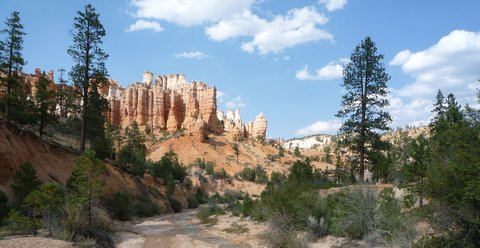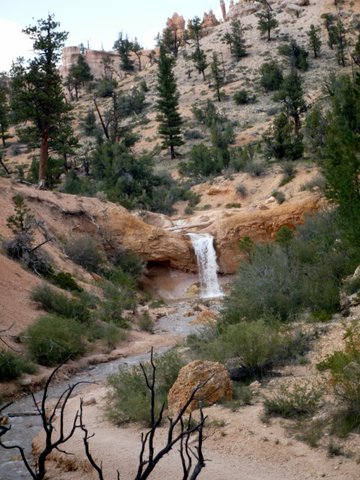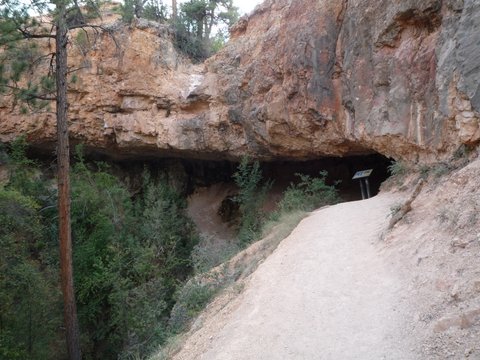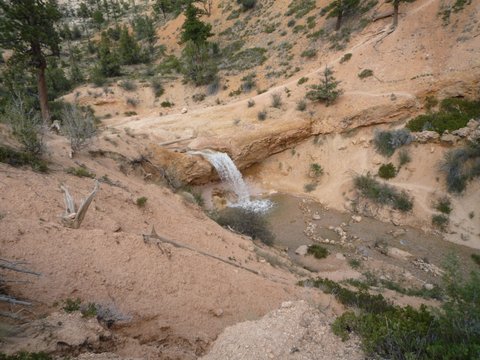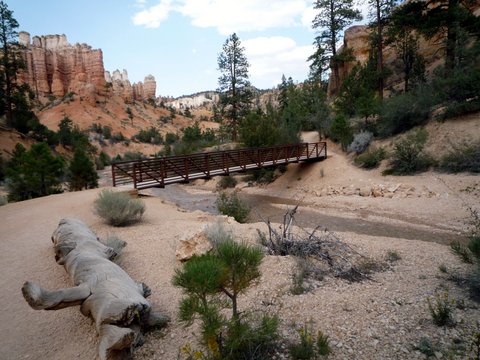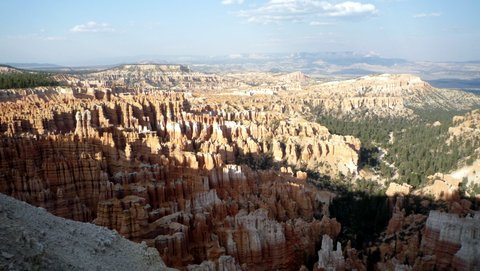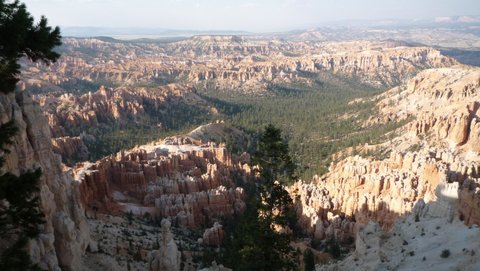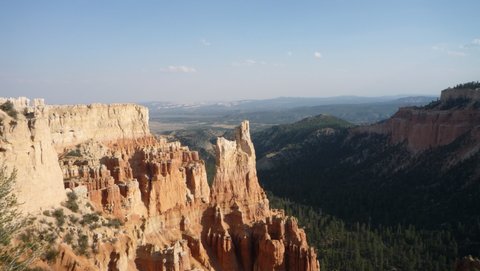Monday afternoon: After lunch, I drove about five miles to the north, into an area of the park called Water Canyon. It is actually outside the entrance to the park, so one can visit this area without paying admission. This area is home to Mossy Cave and a small waterfall. The trail is only about 0.9 miles, each way, with an elevation change of 300 feet.
The higher elevations of this canyon have the texture typical of Bryce Canyon and its hoodoos, while the lower section is without hoodoos.
As you can see, a nice stream runs through this canyon.
Mossy Cave is not a cavern, but only a “shelter cave.” In the winter, it is supposedly filled with giant icicles. On the last day in August, there was no ice left.
Here’s the view from inside the cave, looking out:
Here’s a view of the stream meandering through the canyon:
This is the small waterfall, which flows from May to October.
The Mossy Cave trail here is not a loop, so one returns on the same path. Here’s a view on the way out:
The National Park Service sometimes does a lot to make areas accessible to visitors. They lay out trails, and then preparation can be as simple as making sure that it’s fairly well marked and clear of large obstructions, to more complex preparations, such as adding fill to create a safer, more manageable slope, or in this case adding a pedestrian footbridge. However, the Park Service tries to minimize the environmental impact of the changes they make. For example, if they add walls, they may assemble them from local rocks, or make them from bricks that are a color close to the surrounding terrain. Here, the bridge is painted a dark brown shade that blends well.
Monday late afternoon, August 31:
After leaving Mossy Cave and returning to the main part of the park, I paid short visits to three overlooks. In addition to trails, parks may have overlooks where a visitor can see beautiful scenery without leaving his car, or at least without having to walk more than a few feet from it.
I previously mentioned Sunrise Point and Sunset Point as the start and end points of my three mile hike that morning on the Queens Garden Trail and Navajo Trail. Those were overlooks into Bryce Canyon itself, also referred to as “the Bryce Amphitheater.”
I returned to that general area, and visited the two other overlooks into the Bryce Amphitheater. If you can imagine the Amphitheater as a clock, then Sunrise Point is at the 10 o’clock position, Sunset Point is at the 9 o’clock position, Inspiration Point is at the 8 o’clock position, and Bryce Point is at the 6 o’clock position.
So here’s the view from Inspiration Point, about ½ mile to the south of Sunset Point.
Here’s the view from Bryce Point, about a mile to the southeast of Inspiration Point.
I also took a zoom shot from Bryce Point. I don’t have a superzoom camera; rather, it’s only a 4x-zoom, from 25mm equivalent (a wide angle) to 100mm (twice the normal view). The air quality in that area of the country is excellent, so on a clear day one can see 150 miles! However, as I mentioned, there had been a problem with forest fires, so the sky did appear hazy at times.
The third overlook that I visited that late afternoon was Paria View. It’s about a mile southwest of Bryce Point, and it’s not on the rim of the Bryce Amphitheater, but rather has a view toward the park’s “Pink Cliffs.” However, between the haze and the late afternoon lighting, I don’t think the view is as pleasing as those of the overlooks into the Bryce Amphitheater.
I returned to my campsite for dinner. My camera battery had run down, so I plugged it into the charger and plugged the charger into an outlet at the campground restroom nearest to my campsite.
There was an evening program at the Lodge. The Parks frequently have programs run by rangers. This may include some hikes, or talks at observation points, or talks at the Visitor Center, campsite, or a lodge. This night, the program was on endangered animals. This talk was given by a volunteer, rather than a Park ranger. She mentioned a number of species that were close to extinction that have rebounded to some extent. One species is the Utah prairie dogs, a colony of which lives in Bryce Canyon National Park. Unfortunately, I didn’t see any of them. She claimed that they can run as fast as 40 mph, which is why the speed limit in some areas of the park is 35 mph. I don’t really believe that: it’s not unusual for parks to have such speed limits, as roads are narrow, winding, and drivers need to watch out for other drivers who pull over to admire a site or an animal. Thus, I really doubt that the speed limit was set to allow prairie dogs to run away from a car. The speaker claimed that prairie dogs traditionally lived near the buffalo herds, eating buffalo droppings. At Bryce Canyon, a company has a concession to offer horse rides, and the prairie dogs have found horse droppings to be tasty. Thus, a driver may see these prairie dogs in the road, enjoying something left behind by a horse. She also said that if a prairie dog dies above ground, such as being run over on a road, the other prairie dogs will cannibalize it. She said that they don’t do that if one dies underground. She speculated that they do this so that predators won’t see the dead prairie dog and realize that there are live ones nearby.
After the program, I returned to my campsite and retrieved my camera battery, which had been recharged. People are trusting enough to leave some items plugged in for a couple of hours to recharge, such as an electric shaver, and walk away, expecting they will be there when they return. For that matter, people leave their tents and sleeping bags at the campsite and go away for hours.
I watched the end of the Warehouse 13 episode from the night before, and went to sleep.
Next: The Bristlecone Loop Trail.

